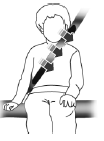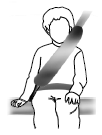Rear inflatable safety belt
WARNING: Do not attempt to service, repair, or modify the rear inflatable safety belt.
Note: The rear inflatable safety belts are compatible with most infant and child safety car seats and belt positioning booster seats when properly installed. This is because they are designed to fill with a cooled gas at a lower pressure and at a slower rate than traditional airbags. After inflation, the shoulder portion of the safety belt remains cool to the touch.
The rear inflatable safety belts are located in the shoulder portion of the safety belts of the second-row outboard seating positions.
The rear inflatable safety belt consists of the following:
• an inflatable bag located in the shoulder safety belt webbing.
• lap safety belt webbing with automatic locking mode.

• Safety belt warning light and chime. See Safety Belt Warning Lights and Indicators in this chapter.

• Crash Sensors and Airbag Indicator. See Crash Sensors and Airbag Indicator in the Supplemental Restraint System chapter.
How Does the Rear Inflatable Safety Belt System Work?
WARNING: If the rear inflatable safety belt has deployed, it will not function again. The rear inflatable safety belt system must be replaced by an authorized dealer.
• The rear inflatable safety belts will function like standard restraints in everyday usage.

• During a crash of sufficient force, the inflatable belt will inflate from inside the webbing.

• The fully inflated belt’s increased diameter more effectively holds the occupant in the appropriate seating position, and spreads crash forces over more area of the body than regular safety belts. This helps reduce pressure on the chest and helps control head and neck motion for passengers.
See also:
Changing the wiper blades
1. Pull the wiper blade and arm away from the glass.
2. Squeeze the locking tabs to release the blade from the arm and pull the blade
away from the arm to remove it.
3. Attach the new blade to t ...
Safety canopy curtain airbags
WARNING: Do not place objects or mount equipment on or near the headliner
at the siderail that may come into contact with a deploying curtain airbag. Failure
to follow these instructions may incre ...
Personal Safety System™
The Personal Safety System provides an improved overall level of frontal crash
protection to front seat occupants and is designed to help further reduce the risk
of airbag-related injuries. The sy ...
